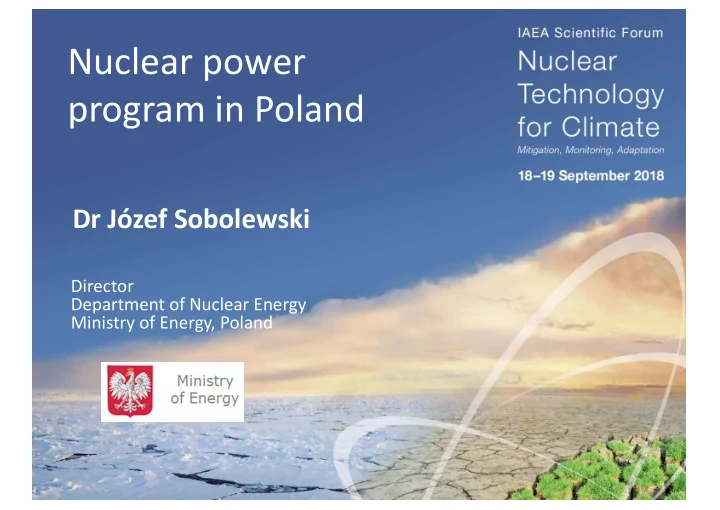

Nuclear power program in Poland Dr Józef Sobolewski Director Department of Nuclear Energy Ministry of Energy, Poland
Polish Power System The total maximum capacity in Polish Power System (PPS) reached 43 421 MW (as of 31 Żarnowiec December 2017). 4x180 MW • Coal-fired power plants – 20 247 MW Żydowo Ostrołęka Lignite-fired power plants – 9 352 MW 3x60 MW • 3x220 MW • Gas power plants – 2 341 MW Pątnów Dolna Odra • Industrial power plants – 2 813 MW 1x460 MW 6x220 MW • Hydroelectric power plants – 2 328 MW 6x200 MW Renewable resources – 6 341 MW • Kozienice • Nuclear: 0 MW 2x500 MW Bełchatów Dychów Adamów 8x225 MW 12x370 MW 3x30 MW 5x120 MW Energy consumption: 1x1075 MW 1x858 MW 168 139 GWh/year (2017) 4,37 MWh/per citizen/year; one of the lowest in Turów Opole Europe. 3x260 MW Łagisza 4x380 MW Stalowa Wola Połaniec According to all estimations energy consumption 3x235 MW Rybnik 1x460 MW 2x125 MW 7x225 MW 2 x120 MW 8x225 MW in Poland will grow in coming decades. Transmission grid - 14 195 km: Siersza Łaziska 2x150 MW 1 line of 750 kV (114 km), • 2x125 MW Solina 2x120 MW • 93 lines of 400 kV (6 326 km), 4x225 MW 2x70 Jaworzno • 164 lines of 220 kV (7 755 km), MW Porąbka-Żar 6x225 Under-sea 450 kV DC connection between 2x30 4x135 MW MW Poland and Sweden(245 km) MW 2
Current and future energy generation structure Assumptions: ü slight decline of consumption of 2016 coal by 2031 and without changes after 2031 14% 1,5 GW by NPP in 2031, 6 -9 GW by ü 2050 3% 5% Average increase of production by ü 2031 0,86% y/y (accelerated increase by 2030, slowdown by 2050) 20% 2050 78% 8% Goal 60% 6% ? 6% Goal 50% coal and lignite nuclear power gas fuels other renewables
Peak load and current and planed capacity [GW] nonDispatchable 40 40 Dispachable Moc dysp. wiatru (el. capacity of wind 35 35 istniejące) 5.6 5.6 5.5 5.5 1.6 2.3 3.0 3.7 5.4 1.3 5.0 1.0 0.7 Dispatchable 0.4 0.0 0.0 0.0 0.0 0.0 0.0 0.0 0.1 0.0 0.0 0.0 0.0 0.9 0.6 30 0.8 0.0 30 0.5 Dispatchable capacity of 3.6 4.7 Reserve gap small power plants and renewables without wind 6.2 7.3 9.1 25 25 Demand gap Wind power plants dispatchable capacity 20 20 Capacity demand Capacity demand 15 15 Dispatchable power plants plus reserve 5,8 GW * 0,9 10 10 5 5 Last coal power plants under construction 0 0 2016 2017 2018 2019 2020 2021 2022 2023 2024 2025 2026 2027 2028 2029 2030 2031 2032 2033 2034 2035 SOURCE: ME, PSE
Main challenges Increasing costs of coal power generation (CO2, air pollutants) Lignite resources already 60 EUR/tCO2 mined out (2040) 50 50 40 44 40 Aging structure of the existing 32 30 25 power plants in Poland (2016) 20 17 11.47.4 9.5 10 0 Source: Polish Energy Market Agency 2017. Projection based on: 1) OECD/IEA, World Energy Outlook 2016, Paris, November 2016. 2) European Commission: EU Reference Scenario 2016. Energy, transport and GHG emissions trends to 2050, July 2016. 3) “Thomson Reuters Carbon Market Survey 2016”, Nordeng, A. et al., May, 2016. 4) KfW/ZEW CO2 Barometer 2016– Carbon Edition.
Electricity generation – CO 2 emission intensity Source: European Environment Agency
Polish Power System - July 2018 (hourly in MW) 25000 20000 15000 10000 5000 14% 0 1 25 49 73 97 121 145 169 193 217 241 265 289 313 337 361 385 409 433 457 481 505 529 553 577 601 625 649 673 697 721 Wind Power Consumption Instaled Wind Power
Polish Nuclear Power Program PNPP was approved on January 28th 2014 by the Council of Ministers. • Its key goals resulting from the Energy Policy of Poland until 2030 are following: ü assuring long-term security of electricity supply ü maintaining electricity prices at levels acceptable by the national economy and the society ü reducing emissions of CO 2 and other air pollutants 2 NPP planned with total installed capacity: 6000 MWe • Current status: • The government is working on update of the document and new business model for the first NPPs. 8
Average CO 2 emission per 1 MWh 1000 [kg Assumptions: CO 2 /MWh] ü 1,5 GW since 2031, 892 900 862 further 2 units after 2 836 and 4 years 821 804 787 782 774 775 766 758 745 7,5-10 GW installed ü 800 capacity in wind turbines 713 702 700 ü Included CCGT, new coal power units, gas 634 634 units, oil units and 600 576 574 other renewables. 520 510 505 495 486 481 500 400 9 Źródło: PSE / ME
Thank you for attention
Recommend
More recommend